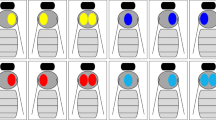Abstract
Adult drone honey bees from 4 Australian breeding lines were reared under similar conditions and examined for semen and sperm production when 14, 21 and 35 days old, during spring, summer and autumn. Almost half (40.5%) of all drones examined did not release any semen when manually everted. For those that released semen, the average volume released per drone was 1.09 μL (range 0.72 (±0.04)−1.12 (±0.04) μL) and the average number of sperms in the semen per drone was 3.63 × 106 (range 1.88 (±0.14)−4.11 (±0.17) × 106). The release of semen was dependent on breeding line and age (P < 0.05), but not on the rearing season. The volume of semen released per drone was dependent on season, age, and breeding line (P < 0.05), while the concentration of sperm in the semen was dependent on season and breeding line (P < 0.05). Hence our data indicate that genetics underpins the maturation of drone honey bees as well as the volume of semen they release and the concentration of sperm in that semen.
Similar content being viewed by others
References
Anderson D.L. (2004) Improving queen bee production, Publication No. 04/153, Rural Industries Research and Development Corporation, Canberra, Australia, 16 p.
Bishop G.H. (1920a) Fertilization in the honeybee, I. The male sexual organs: their histological structure and physiological functioning, J. Exp. Zool. 31, 225–265.
Bishop G.H. (1920b) Fertilization in the honeybee, II. Disposal of the sexual fluids in the organs of the female, J. Exp. Zool. 31, 267–286.
Collins A.M., Donoghue A.M. (1999) Viability assessment of honey bee, Apis mellifera sperm using dual fluorescent staining, Theriogenology 51, 1513–1523.
Collins A.M., Pettis J.S. (2001) Effect of varroa infestation on semen quality, Am. Bee J. 141, 590–593.
Fukuda H., Ohtani T. (1977) Survival and life span of drone honeybees, Res. Pop. Ecol. 19, 51–68.
Gilmour A.R., Gogel B.J., Cullis B.R., Thompson R. (2006) ASReml User Guide Release 2.0. VSN International Ltd., Hemel Hempstead, UK.
Kerr W.E., Zucchi R., Nakakaira, J.T., Butolo J.E. (1962) Reproduction in social insects, J.N.Y. Entomol. Soc. 70, 265–270.
Koeniger G., Koeniger N., Fabritius M. (1979) Some detailed observations of mating in the honeybee, Bee World 60, 53–57.
Koeniger G., Koeniger N., Tingek S., Phiancharoen M. (2005) Variance in spermatozoa number among Apis dorsata drones and among Apis mellifera drones, Apidologie 36, 279–284.
Köhler F. (1955) Untersuchungen zum Problem der künstlichen Begattung der Bienenkönigin (Apis mellifica L.), Würzburg: Inaugral-Dissertation.
Page R.E. (1986) Sperm utilization in social insects, Annu. Rev. Entomol. 31, 297–320.
R Development Core Team (2007) R: A language and environment for statistical computing. R Foundation for Statistical Computing, Vienna, Austria. ISBN 3-900051-07-0, URL: http://www.R-project.org.
Rhodes J., Somerville. D. (2003) Introduction and early performance of queen bees — some factors affecting success, Publication No. 03/049, Rural Industries Research and Development Corporation, Canberra, Australia.
Rinderer T.E. (1986) Bee genetics and breeding, Academic Press, Orlando, Florida, USA.
Rinderer T.E., Guzman L.I., Lancaster V.A., Delatte G.T., Stelzer J.A. (1999) Varroa in the mating yard. 1. The effects of Varroa jacobsoni and Apistan® on drone honey bees, Am. Bee J. 139, 134–139.
Ruttner F. (1956) The mating of the honeybee, Bee World 37, 3–15.
Schlüns H., Schlüns E.A., van Praagh J., Moritz R.F.A. (2003) Sperm numbers in drone honey bees (Apis mellifera) depend on body size, Apidologie 34, 577–584.
Winston M. (1987) The biology of the honeybee, Harvard University Press, Cambridge, Massachusetts, London, England, 281 p.
Witherell P.C (1972) Flight activity and natural mortality of normal and mutant drone honeybees, J. Apic. Res. 11, 65–75.
Woyke J. (1960) Natural and artificial insemination of queen honey bees, Pszczel. Zesz. Nauk. 4, 183–275.
Woyke J. (1964) Causes of repeated mating flights by queen honeybees, J. Apic. Res. 2, 17–24.
Woyke J., Ruttner F. (1958) An anatomical study of the mating process in the honeybee, BeeWorld 39, 3–18.
Zander E. (1916) Die Ausbildung des Geschlechtes bei der Honigbiene (Apis mellifera L.), Z. Angew. Entomol. 3, 1–20.
Author information
Authors and Affiliations
Corresponding author
Additional information
Manuscript editor: Klaus Hartfelder
Rights and permissions
About this article
Cite this article
Rhodes, J.W., Harden, S., Spooner-Hart, R. et al. Effects of age, season and genetics on semen and sperm production in Apis mellifera drones. Apidologie 42, 29–38 (2011). https://doi.org/10.1051/apido/2010026
Received:
Revised:
Accepted:
Published:
Issue Date:
DOI: https://doi.org/10.1051/apido/2010026




